Because of the dual triceps brachii origin at the infraglenoid tubercle of the scapula and the posterior surface of the humerus, only the long head (the biggest head) crosses the shoulder joint.
This means that for maximum muscle growth, you need to train your triceps while your shoulders are in flexion, which is to say with some kind of overhead movement such as a seated tricep extension because this is where the long head is most active.
The seated barbell extension is arguably an even better exercise than the standing overhead barbell extension because the sitting position means that you don’t have to put as much effort into stabilizing your core, which in turn means that you can better focus on training your triceps.
This tutorial demonstrates how to do a seated barbell tricep extension with the optimal form and then explores the pros and cons of the exercise. After that, we’ll look at how many sets and reps you should be doing for hypertrophy.
Seated barbell tricep extension exercise details
- Also Known As: Seated BB extension, sitting barbell extension
- Main Muscles: Triceps
- Exercise Type: Strength
- Exercise Mechanics: Isolation
- Difficulty Level: Beginner
- Equipment Needed: Barbell, weights, bench
How to do a seated barbell extension
- Place a moderate amount of weight onto a barbell. For more convenience, use a preloaded/fixed bar.
- Set the backrest of an adjustable bench to 90 degrees. You can also use a bench with a fixed back pad.
- Grab the bar with an overhand grip, just inside shoulder width.
- Sit on the bench with your back braced against the pad.
- Press the bar over your head so that your elbows are locked out.
- Tuck your elbows in and lower the weight behind your head.
- Descend until you feel an intense stretch in your triceps (i.e., in the backs of your arms).
- Reverse the movement by forcefully flexing your triceps until your elbows reach complete extension.
- Repeat for 3-5 sets of 8-20 reps.
Seated barbell extension pros and cons
The seated barbell triceps extension has a lot of plus points, especially when it comes to gaining mass and isolating your triceps. However, seated BB extensions also come with a few drawbacks that you should consider before programming them into your workout routine.
Pro: Great for gaining triceps strength

The seated straight bar tricep extension is an effective exercise for gaining triceps strength due to the excellent microloadability of barbells.
While exercises like the seated one-arm overhead dumbbell extension can certainly build muscle, they’re not ideal for gaining strength because the weight increments for dumbbells can often be 5 lbs per side.
With barbell exercises, on the other hand, you can make use of small or even fractional weight plates to increase the resistance in really manageable increments, sometimes by as little as 0.25 lbs per side.
Bumping up the resistance by a pound or two might not seem like a massive feat of strength at a glance, but over the weeks and months, these small weight increases really start to stack up, and they eventually translate into bigger, stronger triceps.
Increasing the weight in manageable increments is especially important for isolation exercises like the barbell seated tricep extension because a 5 lb increase, for example, represents a much larger percentage increase on a single-joint exercise than on a compound movement.
This is why, where possible, you should program the resistance of your exercises to increase by a predetermined percentage each session, week, or month.
Pro: It’s a convenient exercise
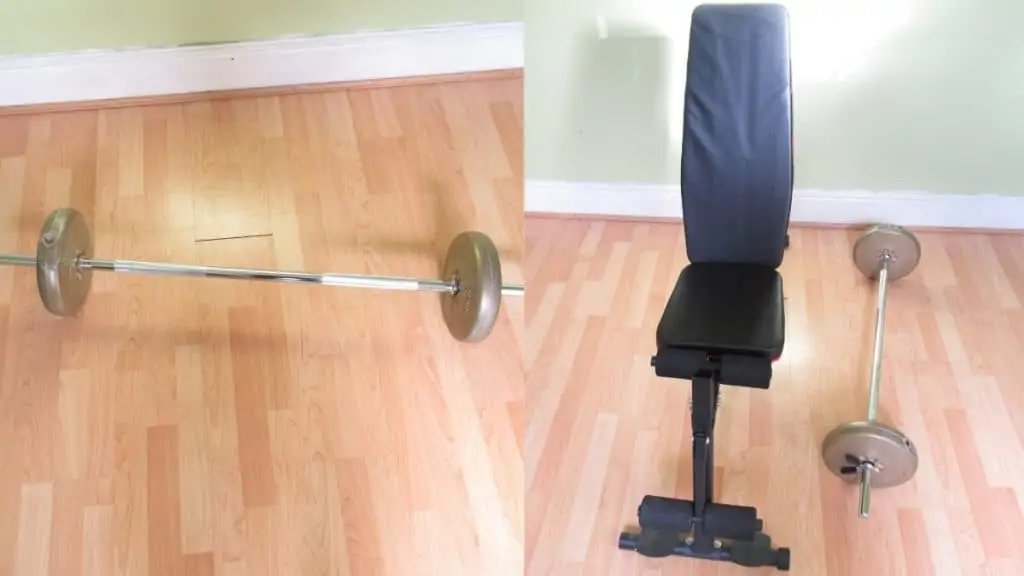
As with lying barbell triceps extensions, you can do seated barbell tricep extensions in virtually any gym, and you can easily replicate the movement at home with basic equipment.
All you need to start gaining from seated barbell extensions is a half-decent bar, a bench, and a few weight discs (if you don’t have a weight bench, you could even use a chair). This low barrier to entry is ideal if you’re training at home with limited equipment or if you don’t want to be tied to a particular gym machine to train your triceps.
Of course, unless you opt for a fixed bar, then you’ll still need to load weights onto the barbell. But this can often be just as quick as getting a particular machine in the correct position for your body.
Pro: It bulks up your arms

Because it places your shoulders into flexion, the seated overhead barbell tricep extension emphasizes the long head of the triceps, which, as mentioned, is (by far) the largest of the three tricep heads.
Considering that the triceps as a whole make up two-thirds of your upper arm size, you can see just how critical it is to train the biggest head of the triceps if you want your arms to grow.
While the biceps may be more visible, especially from the front, nothing makes your t-shirt sleeves tighter than a bulging pair of triceps.
This arm size, of course, isn’t just for show, either.
Growing your triceps via mass-building movements like the seated barbell extension will boost your compound pressing strength and help you to set new PRs because you’ll be able to lock the weight out more effectively.
Con: It could bother your joints
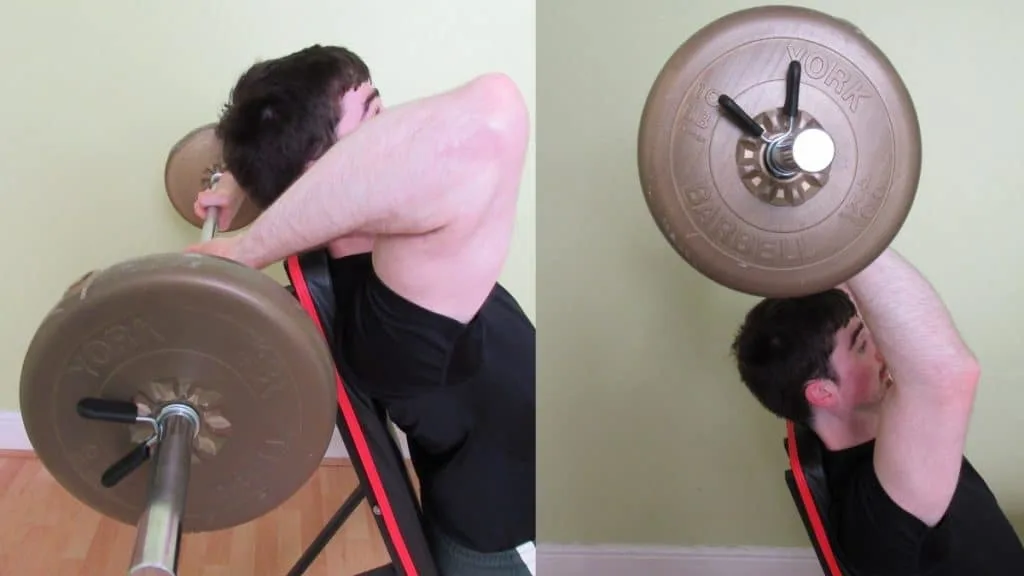
The seated straight bar extension forces your wrists into an extreme amount of pronation, which can cause joint pain for some people.
If you’re lifting fairly light, then you might not feel any discomfort. But if you’re training your triceps to their limit, then using a straight bar might irritate your wrists and make it hard to concentrate on training the target muscles as a result.
The EZ bar overhead tricep extension is a good substitute because EZ bars have semi-pronated grips that are easier to hold than those of straight bars.
Performing a seated overhead cable extension is another good idea for sparing your wrists because you can use a rope attachment to keep your wrists in a neutral position.
Being overhead exercises, however, all of these movements still demand good shoulder mobility—you need to get your arms all the way over your head (so that your elbows are parallel with the floor) in order to make the exercise effective.
If you’re struggling to get your shoulders in the proper position, give barbell incline tricep extensions a try instead. Incline extensions are a cross between lying and upright extensions, and as such, require less shoulder mobility than a sitting barbell tricep extension.
Con: It could lead to tricep size asymmetries
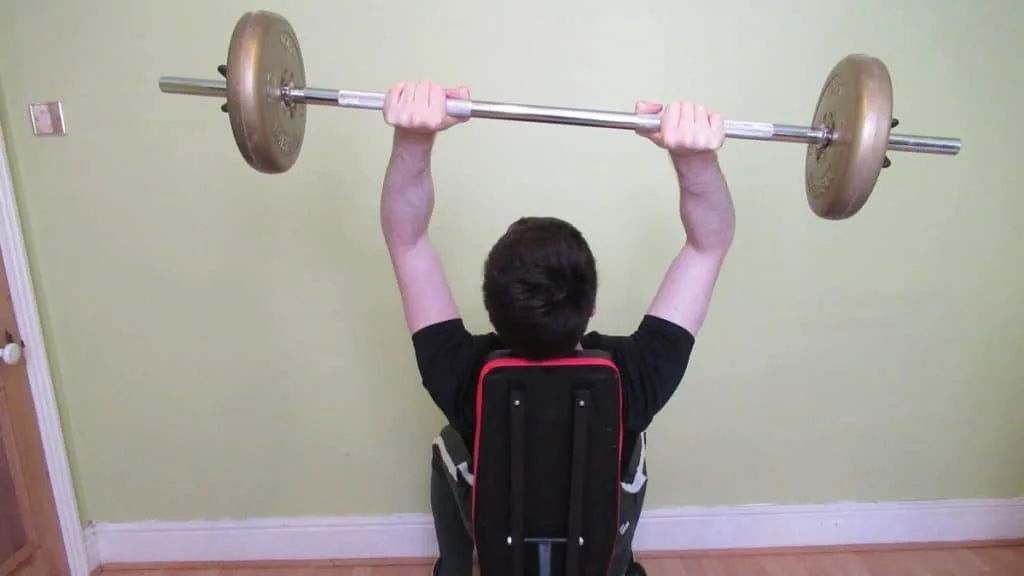
Muscular imbalances of some description are a reality of any barbell-based training program.
The trade-off, of course, is that barbells also build plenty of mass because they enable you to overload your muscles with more resistance than other training tools.
To keep your tricep asymmetries to a minimum, however, you can do the seated barbell overhead tricep extension in front of a mirror so that you can keep an eye on your form. Specifically, you don’t want the barbell to become lopsided because that’s a strong indication that one of your triceps is doing more of the lifting (and thereby receiving more of the tension) than the other.
Con: It doesn’t burn many calories

The seated overhead barbell tricep extension burns fewer calories than the standing version because your abs and the muscles in your legs aren’t as active.
Therefore, if you’re trying to lose body fat, you should perform your tricep extensions in a standing position where possible.
On the other hand, you may actually want to conserve energy by sticking with the seated barbell overhead tricep extension if you’re trying to gain weight.
The difference in calorie expenditure between the two positions, however, is likely trivial when you look at the big picture, so you should just go with whichever exercise you find the most comfortable.
Seated BB extension sets and reps
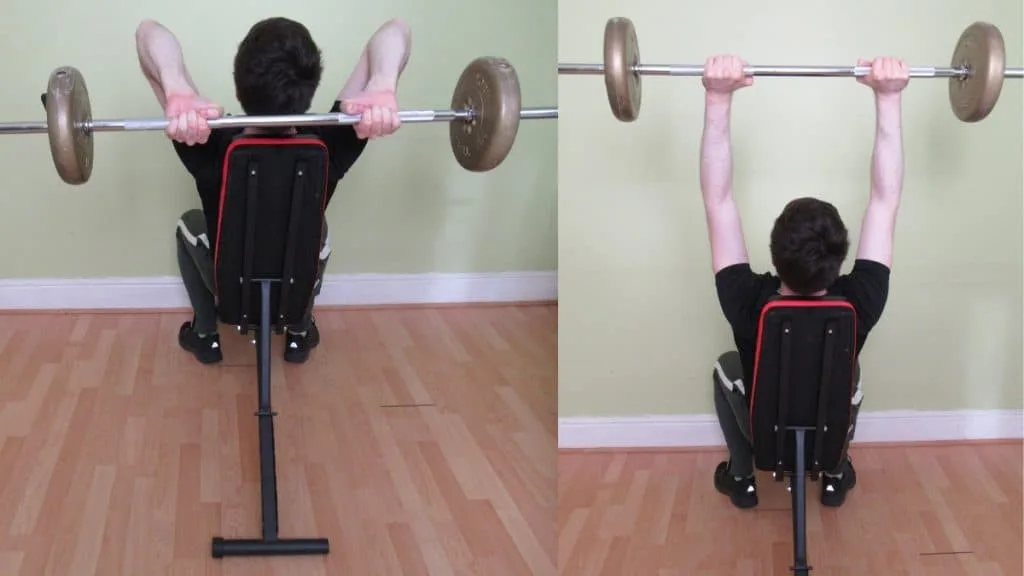
Perform 3-6 sets of 8-15 reps of the seated barbell overhead extension 1-2 times per week.
Do more sets if you’re an advanced lifter and fewer sets if you’re a beginner or intermediate.
Also, the higher the number of total tricep exercises that you have in your program, the fewer sets you should perform for each individual exercise. This way, your total training volume won’t become excessive.
Moderate reps (8-15) are most recommended for seated barbell overhead extensions because they offer a good balance between heavy lifting and what bodybuilders call the pump.
The triceps respond excellently to heavy weight and low reps, which is why they can realize much of their size potential from compound presses alone. For most lifters, however, massively heavy weights and tricep isolation exercises (especially overhead movements) don’t really mix.
So if low reps bother your joints, it follows logically that moderate reps are your next best option.
Since your triceps only respond to tension, lifting lighter weights for higher repetitions also works well. The problem with high reps is that they generally have a very poor stimulus to fatigue ratio, which is to say that they create a disproportionate amount of full-body fatigue compared to the amount of tricep stimulation that they provide.
As for training frequency, you should only perform barbell seated extensions 1-2 times per week so that your joints, tendons, and ligaments have enough time to recover.
If you or your coach believes that you should train your triceps more than twice a week, then you can do so with other exercises like pushdowns, but make sure to limit overhead movement to twice-weekly so that your elbows don’t take too much of a beating.
Conclusion: Are seated barbell extensions worth including in your workout routine?
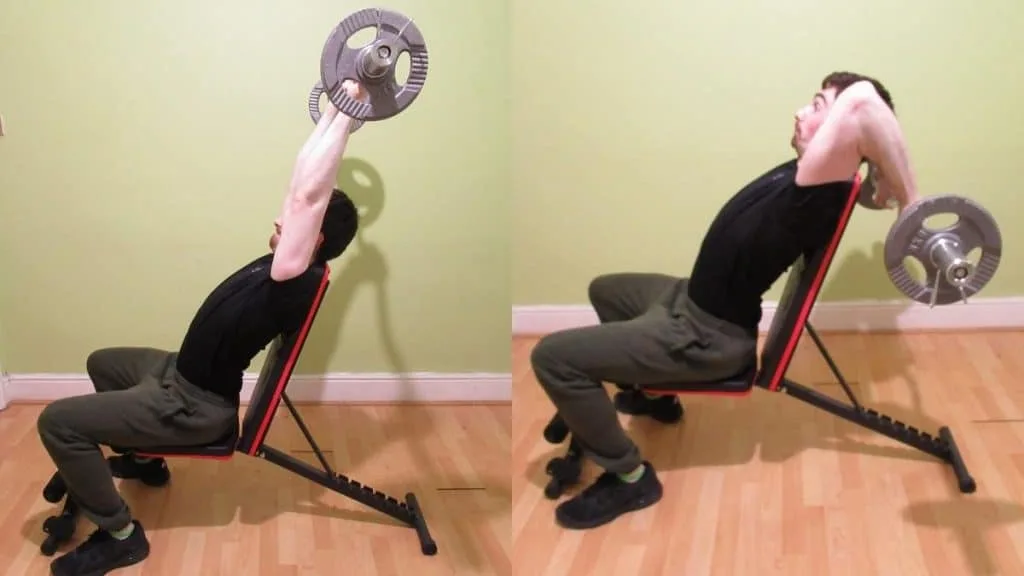
If you want to maximally isolate your triceps, then the seated barbell extension is definitely worth including in your workout routine.
Unlike standing reverse grip overhead triceps extensions, seated barbell extensions enable you to give maximum attention to your triceps because you don’t have to put as much effort into stabilizing your core when your torso is braced against the backrest of the bench.
The only real drawback of the seated barbell tricep extension is that it can lead to muscular imbalances if you allow the bar to become too lopsided. This is a problem that you can mostly remedy by performing the seated BB extension in front of a mirror.

